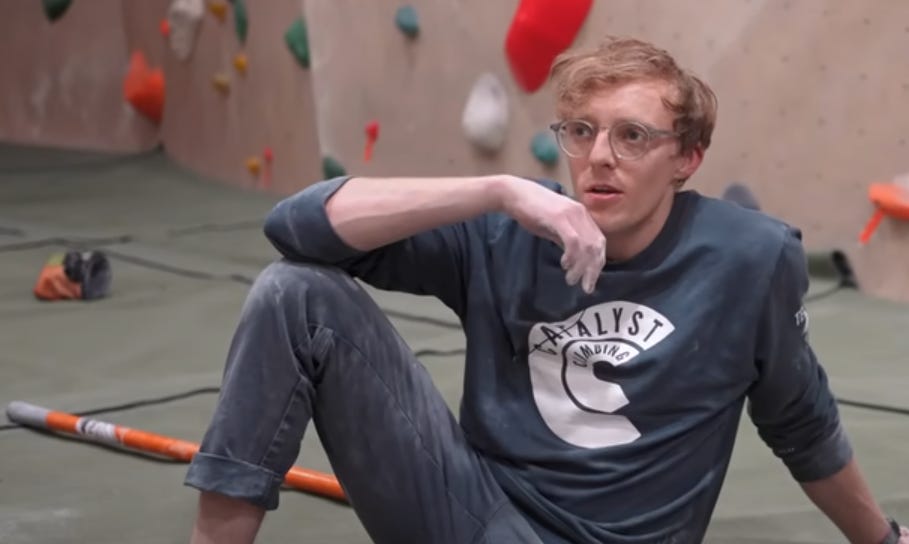Bouldering Tip: Stop Taking Snapshots (Louis Parkinson)
Instead, look at this picture of my potential!
“Taking a snapshot of our performance, and basing all of our performance and our value on just that snapshot, I think that’s the mistake”
- Louis Parkinson
You've sent a v5 problem. That's great! But don't call yourself a v5 climber. You're only setting yourself up for unnecessary disappointment and harmful self-criticism.
I’m making a card game you play at the bouldering gym! Subscribe to stay updated on the progress and learn when you can get the game yourself.
Now, if I may pat myself on the back for a moment here, this lesson is one I arrived at myself (in different words, of course). But, I did so not out of some kind of training-focused sense of eventual competitive edge. No. I did so out of self-deprecating humility. I consider luck to be a heavy ingredient in most of my new-grade sends, and therefore I accept every such send as less a testament to my climbing progress and more a testament to how soft the problem is or how I must have absorbed beta through osmosis as better, stronger, and overall more able climbers sent the problem before me.
In short, I think of a new-grade send as a milestone. I’ve even said as much in a video on my YouTube channel:
“I don’t generally talk or even care about grades. I find them useful only as measures of personal success, not as skill titles. So, for example, if I generally climb v5 problems, but fall on a v1 or v2, I don’t see that as a failure, because I don’t see myself as a v5 climber. Rather, I’m a climber who has climbed v5s. The v5 is a milestone, not a standard.” (via me)
(yes, I see the irony in quoting myself immediately after expressing how humble I am)
Parkinson’s use of “snapshot” as a metaphor for a point in time is incredibly insightful. The idea that a single moment is meant to represent an entire future of potential is absurd. But much like humans treat a photograph, it’s hard to divorce ourselves from the tactile truth of a still image. We see people looking gorgeous on Instagram photos and are convinced that they are always gorgeous. We see a mugshot and convince ourselves that the criminal is always a criminal.
It’s hard to divorce ourselves from the tactile truth of a still image.
The human brain hunts for, and depends upon, shortcuts. It’s what allows for racism, sexism, and all sorts of hatreds. But it’s always what allows us to avoid snakes (and not have to investigate every single snake individually for deadly potential). Shortcuts are what allow us to associate a cup of coffee and a windowsill as an opportunity for relaxation (and not worry about that particular windowsill being full of termites or that particular cup of coffee being laced with ricin).
Shortcuts can be helpful, but they can also be incredibly destructive.
Let’s do an exercise. Take out your phone. Position it in front of your face as though you are taking a selfie. But first, before you snap that photo, make the most unflattering face you can possibly make. Play with low angles. Mess up your hair. Now, snap the photo.
Look at the image. Do you consider this an accurate representation of how you generally look? Of course not. So why would you consider a single send, or a single failure, an accurate representation of your skill.
Do you consider this an accurate representation of how you generally look? Of course not. So why would you consider a single send, or a single failure, an accurate representation of your skill.
Keep this photo on your phone. Pull it out anytime you start feeling bad about yourself when you fail a send. Remember: a grade is a milestone, a measure of potential. A grade is now who you are.
A quick note on my own education. Over the past few weeks, as I’ve collected these lessons and forced myself to chew on them and to digest them, with the goal of expelling them for all of you lovely readers to gobble up (gross), I’m recognizing patterns. And these patterns are what people who study intelligence call…intelligence (of which, I am not one as evidenced by the fact that I couldn’t come up with another word for “intelligence” just now).
So much of what I find helpful for my climbing progress involves simply reframing goals. Hazel Findlay’s tip about using an effort index, Hannah Morris’s tip about using ‘could’ not ‘should’, and even Jenya Kazbekova’s tip about de-emphasizing the flash, these are all just different ways goal-ifying the journey rather than the send.
If this Substack were a book, “goal-ify the journey, not the send” would be an appropriate throughline.
Answer in the comments, did you actually take a picture of yourself as I suggested in the exercise above?
Do you have any bouldering tips to share? Leave links to articles or videos that you’ve found helpful.
Subscribe for weekly free tips from climbing pros.
The climber: Louis Parkinson
The source: BIGGEST MISTAKES Coach Louis Sees at Every Grade (V0-V9+)



